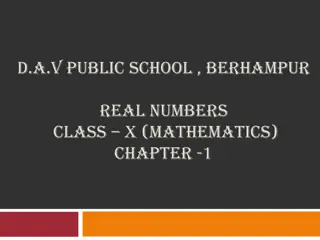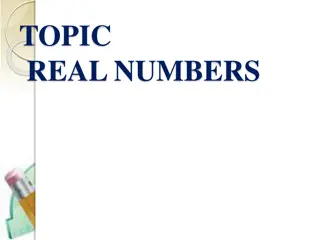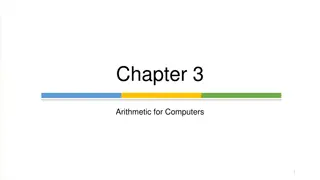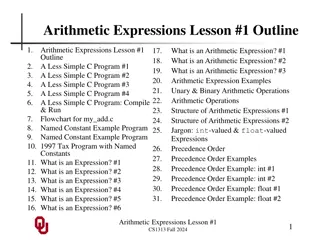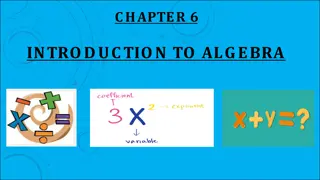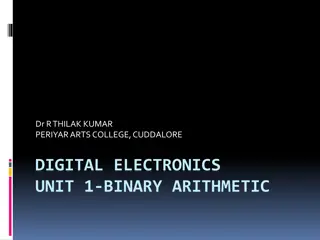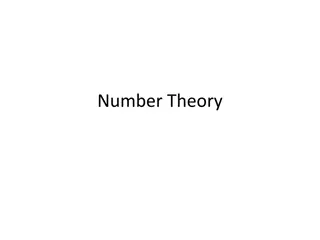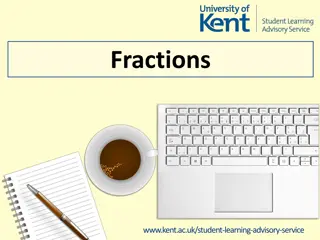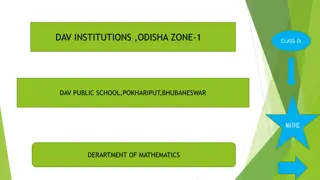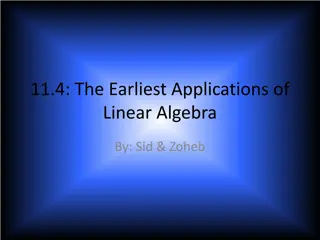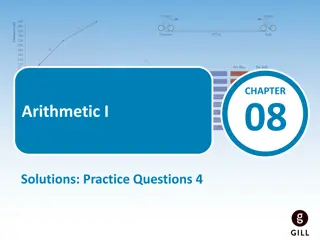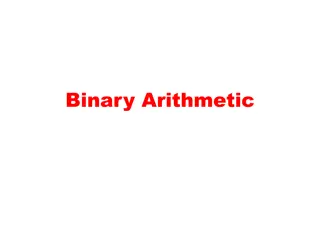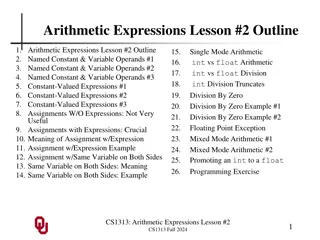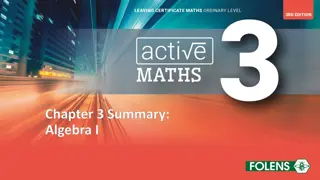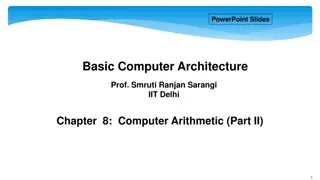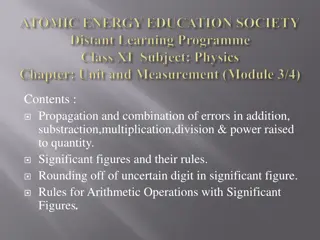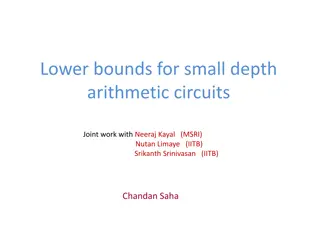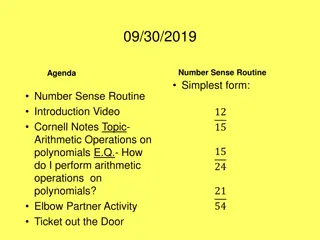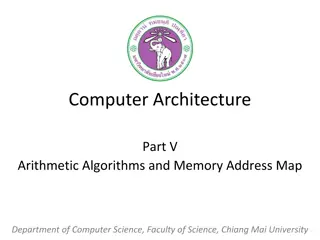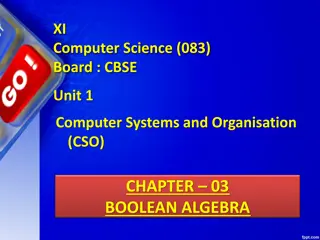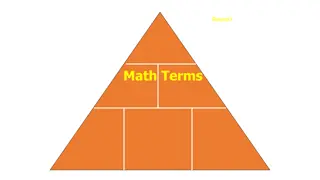Understanding Real Numbers and Basic Arithmetic Operations in Algebra
Review essential concepts from the first chapter of "Intermediate Algebra" by Gustafson and Frisk. Learn about the classification of real numbers, graphical representations on the number line, intervals, arithmetic operations such as addition, subtraction, multiplication, and division of real numbers. Understand the rules for adding and multiplying numbers with the same or opposite signs.
Download Presentation

Please find below an Image/Link to download the presentation.
The content on the website is provided AS IS for your information and personal use only. It may not be sold, licensed, or shared on other websites without obtaining consent from the author. Download presentation by click this link. If you encounter any issues during the download, it is possible that the publisher has removed the file from their server.
E N D
Presentation Transcript
Intermediate Algebra by Gustafson and Frisk Chapter 1 A Review of Basic Algebra
Section 1.1: The Real Number System SETS: collections of objects. Natural Numbers Whole Numbers Rational Numbers Irrational Numbers Real Numbers Use { } {x | x > 5} Integers Positive Numbers Negative Numbers Even Numbers Odd Numbers is read the set of all x such that x is greater than 5
Section 1.1: The Real Number System GRAPHS: plot on the number line. Individual numbers are dots -3 -2 -1 0 1 2 3 4
Section 1.1: The Real Number System GRAPHS: plot on the number line. Intervals including end points [ -3 -2 -1 0 1 2 3 4 [ ] -3 -2 -1 0 1 2 3 4
Section 1.1: The Real Number System GRAPHS: plot on the number line. Intervals not including end points ( -3 -2 -1 0 1 2 3 4 ( ) -3 -2 -1 0 1 2 3 4
Section 1.2: Arithmetic & Properties of Real Numbers OPERATIONS: Addition Subtraction (the same as adding a number with the opposite sign) Multiplication Division (the same as multiplying by the reciprocal)
Section 1.2: Arithmetic & Properties of Real Numbers ADDITION: Addends that have the same signs Add absolute values Keep the sign of the addends Addends that have opposite signs Subtract absolute values Keep the sign of the addend with the largest absolute value
Section 1.2: Arithmetic & Properties of Real Numbers MULTIPLICATION: Multiply absolute values If the factors have the same signs, the product is positive If the factors have opposite signs, the product is negative
Section 1.2: Arithmetic & Properties of Real Numbers STATISTICS: measures of central tendency Mean Median Mode
Section 1.2: Arithmetic & Properties of Real Numbers Properties: Associative addition, multiplication Commutative addition, multiplication Distributive multiplication is distributed over addition a (b + c) = ab + ac
Section 1.2: Arithmetic & Properties of Real Numbers Identities: Addition zero Multiplication one Inverses: Addition opposites Multiplication reciprocals
Section 1.3: Definition of Exponents EXPONENTS: repeated multiplication In the expression: an a is the base and n is the exponent Exponents are NOT factors Means to multiply a n times
Section 1.3: Definition of Exponents ORDER OF OPERATIONS: If an algebraic expression has more than one operation, the following order applies: 1. Clear up any grouping. 2. Evaluate exponents. 3. Do multiplication and division from left to right. 4. Do addition and subtraction from left to right.
Section 1.5: Solving Equations Algebraic Expression vs. Equation Expressions: a combination of numbers and operations Equation: a statement that two expressions are equal
Section 1.5: Solving Equations EXPRESSIONS: Terms Like terms When multiplying, the terms do not need to be alike Can only add like terms!
Section 1.5: Solving Equations TO SOLVE AN EQUATION IN ONE VARIABLE: If you see fractions, multiply both sides by the LCD. This will eliminate the fractions. Simplify the algebraic expressions on each side of the equal sign (eliminate parentheses and combine like terms). Use the addition property of equality to isolate the variable terms from the constant terms on opposite sides of the equal sign. Use the multiplication property to make the coefficient of the variable equal to one. Check your results by evaluating.
Section 1.5: Solving Equations TYPES OF EQUATIONS: CONDITIONAL: if x equals this, then y equals that. IDENTITY: always true no matter what numbers you use. CONTRADICTION: never true no matter what numbers you use. FORMULAS: conditional equations that model a relationship between the variables.
Section 1.6 & 1.7: Solving Problems, Applications TYPES OF PROBLEMS: Geometry Percent Physics (forces) Uniform motion Mixtures Good ole common sense analysis
Chapter 1: Basic Algebra Review SUMMARY: KNOW YOUR VOCABULARY! You can t follow directions if you don t know what the words in the instructions mean. Memorize the processes and the properties. I will provide formulas for your reference. Ask questions if you are unsure. Always check your work to make sure that you answered the question, and that your answer is reasonable.
This powerpoint was kindly donated to www.worldofteaching.com http://www.worldofteaching.com Is home to well over a thousand powerpoints submitted by teachers. This a free site. Please visit and I hope it will help in your teaching


